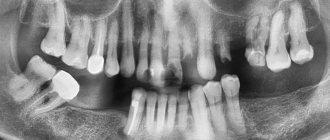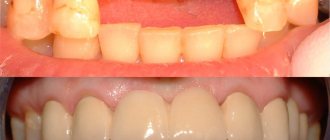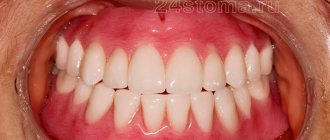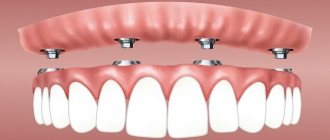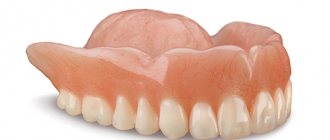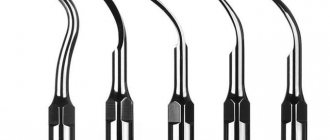A dental crown is a separate type of orthopedic structure used in dentistry to restore the shape, aesthetics and functional functions of a dental unit. Single crowns are used in the process of restoring severely damaged teeth: for example, if due to illness or injury the natural crown has been destroyed by more than fifty percent, it is more correct to restore it not with filling composites, but by installing a dental crown. Dental crowns are also actively used in prosthetics, for the restoration of missing units. Most often, a dental bridge is used for this purpose - a structure in which several dental crowns are connected. The finished prosthesis is fixed in the oral cavity on the supporting teeth, previously prepared to the thickness of the crowns. Bridges are used when there is a defect in a row with the absence of no more than two dental units in a row.
Calculate the cost of treatment by taking a short test in 20 seconds!
Do not delay your treatment, because in this matter time plays against us.
Photos of a single crown and dental bridge will help you get an idea of what the structures look like.
Before restoration with crowns, not only preliminary grinding of the supporting teeth is required: the teeth should be treated for carious damage, restored with a filling, and sometimes endodontic treatment may be required. Professional sanitation of the oral cavity is also recommended. All of the above measures allow restoration with crowns to be carried out with the highest possible quality, without the risk of complications in the future.
When is it indicated to install crowns on teeth?
The main indications for installing dental crowns are as follows:
- Severe destruction of the dental unit, in which the natural crown of the tooth has collapsed by more than fifty percent;
- In case of single defects in the dentition (when no more than two units in a row are missing in a row);
- Aesthetic restoration to achieve an attractive tooth color and shape.
Less commonly, crown prosthetics act as an alternative to orthodontic treatment in situations where it is necessary to change the position of one tooth in a row.
USEFUL TO KNOW: Teeth that are more than 50% damaged due to caries or for other reasons should be restored with a crown, not a filling. Large fillings installed quickly on pins fall out, and in addition, teeth filled under such circumstances usually come out of the bite, which can lead to its failure and disruption of the correct distribution of the chewing load.
An even worse option is that a tooth with a huge filling simply cannot withstand the pressure that occurs when chewing food and breaks, and if a pin is placed, the root of the tooth unit may also be damaged. Trauma to the tooth root suggests only one outcome - tooth extraction.
Prosthetics with crowns has not only indications for implementation, but also contraindications, which are important to exclude before starting the treatment process. Crowns are not installed:
- With mobility of the dental unit;
- Abnormally low height of the natural coronal part of the tooth, leading to the collapse of the orthopedic crown;
- When there are a significant number of teeth in rows.
It will be necessary to postpone restoration with crowns even if the diagnosis reveals an inflammatory process in the upper part of the root system of the tooth or poor-quality filling of its canals.
Under such circumstances, it will be necessary to take measures to eliminate temporary contraindications to crowns and only after that the restoration procedure itself.
What are crowns needed for?
A crown is a denture and is an imitation of a real tooth. It can replace a lost tooth, and also fix a weakened or destroyed dental organ.
If only the root remains of the tooth, a pin or inlay is inserted into it, onto which the crown is then attached. If there is a crown part of the tooth, when it is in poor condition, the tooth is depulped, ground down and a crown is put on it. A crown makes sense when the tooth is more than half destroyed, as well as when there is excessive abrasion of the enamel and visual defects (cracks, stains, etc.).
In prosthetics, both single crowns and products welded together into a bridge can be used.
Dental crowns: classification, overview of characteristics and prices for different types of crowns
The classification of dental crowns is carried out according to the material of production. Crowns made of metal alloys of various metals are in maximum demand: they are durable and at the same time have an affordable price for most patients. However, let us make a note - crowns made from alloys of ordinary metals - cobalt, chromium, nickel - will be inexpensive. Crowns made of precious metals are much more expensive and the price of the products will be directly related to their weight.
No less popular types of crowns are structures made of dental ceramics, which include crowns made of zirconium, porcelain, and lithium disilicate. Each type of product has its own unique performance characteristics, which will be useful to learn about in advance, if only because they will have an active influence on the price of the crown.
The cost of a crown per tooth varies from one dentist to another. At the current time, the price of a crown per tooth unit will be:
- Metal-ceramic crown - from 5 to 16 thousand rubles;
- Ceramics - from 16 to 25 thousand rubles;
- Metal crowns - about 5 thousand rubles.
USEFUL TO KNOW: Of course, the price of crowns may seem high, but it is wrong to think that it is so high only because dentists want to profit from patients. The cost of a crown depends on the cost of the material for its production and the complexity of the manufacturing technology. And the production material and technology - the strength of the crown, the timing and comfort of its operation will depend on these factors.
For example, the most inexpensive option is all-metal crowns. However, the aesthetics of such structures are extremely poor; they are practically not used for restorations in the smile area. Therefore, when choosing a crown, you should focus primarily not on the price, but on the result of the restoration you want to achieve. If aesthetics and the durability of the crown are important to you, you should choose crowns made from more expensive materials produced using computer modeling technologies. If the masticatory unit is restored with a crown, you can save money and choose a high-quality and at the same time budget option for the prosthesis.
Below we will consider in detail the features of different types of crowns and find out their approximate cost.
What are they?
Crowns are divided primarily according to the material from which they are made. Let's consider each variety separately.
Metal
Such prostheses have been used for a long time, and have a considerable number of positive aspects. They are very durable, long lasting, comfortable, resistant to caries and biocompatible thanks to the special alloys used in their manufacture. Their main disadvantage is that they are very different from real teeth and, for this reason, unattractive. Therefore, they are not used for front teeth. But for chewing units they are an excellent solution.
This type of prosthesis cannot be placed on people with an allergic reaction to metal, and if there is a possibility of a galvanic effect.
Metal crowns can be made from alloys of simple metals (steel, cobalt, chromium) and from precious metals - alloys of gold, silver and palladium. All of them cope well with chewing loads.
You can learn more about metal crowns here.
Metal-ceramic
They can be called a compromise between aesthetics and durability. The surface of the products is ceramic, and inside there is a metal base. They serve for about 8 years. They look attractive at the same time.
The metal frame can be made of an alloy of gold, platinum and palladium. Such products look more natural due to the yellowness of such a base, which will not give off an unnatural grayish tint through the metal, as is the case with the use of steel, cobalt, nickel, etc.
More detailed information about metal-ceramic crowns can be found here.
Ceramic
Prostheses made of metal-free ceramics are superior to others in terms of aesthetics. They are as similar as possible to living teeth. They can be made from porcelain (pressed ceramic), aluminum oxide, or zirconium dioxide.
Porcelain dentures are ideal in terms of external characteristics. Zirconium dioxide is stronger than aluminum oxide. The latter is lighter than the former and is more often used in aesthetic dentistry. It will look great on the front teeth, but this material is not suitable for crowns on chewing teeth.
Zirconium dioxide crowns are durable. Can last 15–20 years. They are absolutely biocompatible with human tissues and do not cause allergies. The wear resistance and at the same time high aesthetics of such crowns make them very popular.
You can learn more about ceramic crowns in this article.
Metal-plastic
These products are cheaper than all of the above. They are based on inexpensive metals - cobalt, chromium, nickel. They are used as temporary crowns. Products last 2-3 years. They are not durable and may change color over time and cause irritation in the mouth.
More complete information about metal-plastic crowns can be found here.
Plastic
These products are also used for temporary wear. They are characterized by increased lightness, speed of production and low price. They can be installed on ground teeth or implants while their permanent replacements are being prepared.
Dental crowns are also classified according to the size of the dental segment covered. The following types are distinguished:
- full products that envelop the entire area of the tooth;
- equatorial - fit the tooth only to the equatorial point (used in splinting structures);
- half-crowns - they partially cover the tooth, from the lateral, lingual or palatal part (they are placed only on living teeth, while the foreground of the organs is not disturbed);
- stump inlays - inserted into the tooth and covered with a prosthesis (they are often used for the restoration of front teeth).
You can learn more about plastic crowns in this article.
Metal-ceramic crowns: features, cost of prosthetics
The basis of this type of crown is a solid metal alloy frame, the average thickness of which is about 0.5 millimeters. From the outside, the metal base is covered with several layers of ceramic mass, which allows you to obtain an aesthetic appearance of the prosthesis, visually indistinguishable from natural teeth. The base can be made from both inexpensive metals and precious metals - gold and platinum.
USEFUL TO KNOW: In terms of price, a platinum crown is only slightly cheaper than a metal-free product, but at the same time its aesthetic indicators are lower, since even the precious metal will shine through the ceramics.
The advantages of metal-ceramic crowns include: reliability and durability, good aesthetics, affordable price (if we are not talking about products made of platinum or gold). The disadvantages of metal-ceramic crowns will be the following: before prosthetics, a significant amount of tissue is removed from the supporting teeth, teeth often need to be depulped first, and the gum tissue around the crown can acquire an unsightly bluish tint. This defect in metal-ceramic crowns is especially noticeable and critical when performing prosthetics in the smile area.
USEFUL TO KNOW: The defect of cyanosis of the gums occurs due to contact of the crown with soft tissues. To avoid the occurrence of such an unpleasant phenomenon, you can order in advance the production of a prosthesis with a shoulder mass, in which the lower part of the base of the product is also covered with a layer of ceramics. Prostheses with shoulder mass have a more complex production technology, and therefore their price is higher than for conventional crowns.
Having understood the features, advantages, and disadvantages of metal-ceramic crowns, we can move on to considering their cost. On average, a crown of this type, made of high-quality alloy, will cost about 8,000 rubles. If expensive ceramic materials are used for veneering the crown, allowing for high aesthetics of the product, the price of the crown will be higher and can amount to 10 thousand rubles.
The price of crowns with shoulder mass will be even higher - from fourteen thousand. Prices for metal-ceramic crowns may be lower - 5-6 thousand rubles, but usually at this price they offer products in the production of which domestically produced materials were used. Let’s be honest, the domestic product does not meet European quality standards, and therefore the finished crowns will not be distinguished by high levels of aesthetics and reliability.
Crowns with a base of gold or platinum cost about 10 thousand rubles. But the indicated amount is the cost of manufacturing the prosthesis, to which should be added the price of the precious metal per gram of weight. As a result, the price of the crown is already a different amount - from 18 thousand rubles.
It is important to note: the price of crowns does not include pre-treatment services and the cost of a temporary prosthesis.
Care
If you have dentures in your mouth, you should practice more careful oral hygiene. With a single crown, it will be enough to use a toothbrush, floss and toothpaste.
If you have bridges, hygiene can be significantly more complicated. Food often gets clogged under such a structure, which can sometimes be difficult to remove when using a brush or even thread.
But an irrigator can handle this well. A stream of water is supplied from it under pressure, which washes away food debris, soft plaque, and at the same time massages the gums.
Possible problems after installing crowns:
- The occurrence of caries under the crown. This occurs due to the formation of inflammation under the prosthesis due to poor cleaning of the dental canals or poor installation of the structure.
- Mobility of the prosthesis - can occur when poor cement is used to secure it or the shape is poorly calculated.
Ceramic (metal-free) crowns: overview of types, performance properties and prices
The main difference between such crowns and metal-ceramic analogues is that they are produced without a cast metal alloy frame and this gives two advantages at once: high aesthetics and the possibility of using crowns in patients with allergies to metals. The aesthetic and most natural appearance is ensured by the translucency of the ceramic; according to this property, the material will be almost identical to natural tooth enamel.
USEFUL TO KNOW: Opaque ceramic masses are used for veneering metal-ceramic crowns, and therefore the finished crown will look somewhat unnatural.
Ceramic crowns can be made from zirconium dioxide or E.max glass ceramics. Both crown materials have high levels of transparency and therefore products made from them will look natural and visually indistinguishable from natural teeth.
Caring for dental crowns after prosthetics
How long the installed structure will last depends not only on the quality of dental services, but also on proper care. After installing a crown, it is important to follow these recommendations:
- You will be able to eat 2 hours after installation of the prosthesis, and drink immediately;
- For the first few days, it is better to chew solid food on the opposite side; over time, the load can be increased, but you should no longer chew nuts at all;
- after installing prostheses made of plastic or metal-ceramics, it is better to avoid taking coloring foods: coffee, beets, red wine, etc.;
- after each meal you need to rinse your mouth, using an irrigator to rinse the interdental spaces; It is better not to use dental floss, as they can damage the denture;
- brush your teeth twice a day with a soft toothbrush and toothpaste without abrasive particles; President pastes with an RDA abrasiveness rating of less than 50 units are suitable. (Preggy for pregnant and nursing mothers and Junior).
Crown care products
Zirconium crowns
An innovative CAD/CAM manufacturing technique is used to produce zirconium dioxide crowns. It allows the production of orthopedic structures with minimal human intervention. Crowns are turned using milling equipment, and their layout is made using special computer technologies.
Zirconium is a unique material; it not only has optimal biocompatibility with the human body, but also high strength, comparable to the strength of metal. The cost of zirconium crowns starts from 16 thousand rubles.
Two types of zirconium crowns can be used for restoration and prosthetics:
- Two-layer, that is, consisting of a zirconium frame, which is subsequently covered with ceramic mass. The use of this type of crown allows you to obtain the most aesthetic result of restoration, but there is also a minus - if used incorrectly, the ceramics from the frame may chip and the prosthesis will have to be restored;
- Monolithic crowns are machined from solid zirconium blocks and do not have a porcelain outer layer, but in terms of aesthetics they will be significantly inferior to the first type of product.
If prosthetics are performed in the area of the front teeth, where aesthetics are important, glass-ceramic crowns may be the best choice.
Time and stages of making dental crowns
To make permanent dental crowns, the dentist will require an average of a week and 2-3 patient visits.
- First visit The doctor conducts a functional analysis. Then the teeth are prepared (depending on the type of dental crown). Takes silicone impressions. Makes and fixes temporary crowns on prepared teeth. Determines the color of future teeth together with the patient. Discusses options for crown shapes.
- Second visit (after 7 days) Trying on the finished structure in the oral cavity. Fixation of the crown with double-hardening cement. If the shape or color needs to be adjusted, another visit to the dentist may be required. Metal-ceramic and zirconium crowns are made in a dental laboratory within 7-12 days (depending on the complexity of the work). More than 5 dental technicians are involved in the process.
We strongly do not recommend using advertising products “dental crowns in an hour”, etc.
Unfortunately, technically, modern CAD CAM systems do not reach the level that a dental technician can make (either aesthetically or functionally) the marginal fit of such crowns, and the aesthetic appearance does not stand up to criticism.
Glass-ceramic crowns E-max
Glass-ceramic crowns are an excellent option for those who want to get the most aesthetic results from prosthetics. The cost of one E-max crown is from twenty thousand rubles.
Despite all the advantages, glass-ceramic crowns have one significant disadvantage: they are applicable only in the case of single defects in the dentition. A bridge can also be made from glass-ceramics, but with no more than three crowns, and it is fixed in the area of the front teeth. These limitations are associated with the strength of glass ceramics, which will be insufficient for a massive bridge, which will also be subject to significant load (during the restoration of chewing units).
Single glass-ceramic crowns can be used for prosthetics of any teeth - front and chewing. Such crowns can be monolithic or two-layer; any type of product is produced using computer modeling technology.
What is included in the total cost of dental prosthetics?
When installing a denture, the patient has to bear basic and additional costs. The following require separate costs:
- diagnostics of the dental system using radiography;
- treatment of identified dental diseases;
- preparing teeth for prosthetics (depulping, grinding, removal);
- taking impressions or using a computer modeling method;
- installation of temporary prosthetic structures;
- making permanent crowns or bridges in the laboratory;
- fitting, adjustment, installation of prosthesis.
If prosthetics on artificial roots is used, then the total cost of treatment also includes the cost of implantation.
Cast crowns
The main material for the production of cast crowns is an inexpensive alloy of cobalt and chromium; their surface looks perfectly smooth and even, like well-processed and polished metal. If desired, you can do a finishing gold plating. Cast crowns have good durability and wear resistance, a budget price, but extremely low aesthetics. The average cost of a cast crown is five thousand rubles.
Cast crown products are a good option for prosthetics in the area of chewing teeth; they do not require significant grinding of the teeth that support the fixation of the prosthesis. If such crowns are placed in the smile area, they can be additionally lined with special plastic overlays to achieve greater aesthetics.
Contraindications for installation
To place a crown on a tooth, you need to take into account not only the indications, but also the contraindications. Absolute contraindications include:
- healthy (intact) teeth; the exception is the situation when they are used as a support for other orthopedic prostheses;
- high pathological tooth mobility;
- chronic foci of infection of dental tissues that cannot be treated.
Relative:
- insufficient oral hygiene, caries - prosthetics are carried out after complete sanitation of the oral cavity;
- destruction of the crown by more than half - if the root is preserved, prosthetics are carried out after the pin is installed;
- destruction of the tooth root with its subsequent removal - prosthetics after implantation of a titanium root;
- chronic periodontitis (inflammation of the ligament that holds the tooth in the cell) - prosthetics after complete elimination of the causes of the disease - cysts, fistulas, etc.;
- not fully formed dental roots;
- severe general diseases - high blood pressure, stroke, myocardial infarction - prosthetics are possible after stabilization of the patient’s general condition.
Stamped crowns
In modern dentistry they are used extremely rarely, since they have few advantages, but a significant number of disadvantages. Stamped crowns are produced from a special type of blank - metal sleeves. Such a crown can be made with gold or silver plating.
As mentioned above, crowns using the stamping method were valued for their low price and the absence of the need to sharply grind the supporting teeth, but stamped crowns do not have an aesthetic appearance, quickly deform, and do not fit tightly to the neck of the tooth, which is why residues can get under the crown food, saliva and, naturally, pathogenic microflora. Caries under stamped crowns was not uncommon!
Alternatives to crowns
Crowns can be replaced with other alternative products. These include:
- Veneers are coverings for teeth. To install them, a minimum layer of tooth is ground down. Its depulpation is not carried out. These microprostheses are used on 10 upper and 8 lower dental units. They correct the color of the teeth, close the gaps between them, and even their curvature. Such overlays are quite expensive.
- Filling materials. They are used if the tooth has minor damage (less than 1/2). If there is sufficient damage, a pin or stump is placed in the root of the tooth to strengthen it, and then they are covered with filling material. This type of restoration can maintain a tooth in working condition for only a few years. Filling material changes color over time.
- Implants - they are used if it is necessary to replace one or two missing teeth in a row. In such a situation, an alternative to a crown bridge may be implantation. In this case, you do not have to grind down the adjacent teeth, since the prosthesis is placed on a metal rod implanted into the jaw bone.
Gold crowns
Gold crowns are not installed in every dentistry - working with precious metals requires a special license, which is quite difficult to obtain. Moreover, the cost of a finished gold crown is equal to the price of a more aesthetic ceramic crown, so it is unlikely that you will be able to save money on installing gold dentures.
The price of a gold crown will be calculated as follows: the price of the precious metal in grams is added to the cost of manufacturing the prosthesis. The total amount of precious metal that goes into the production of the crown is taken into account. How much metal is required is a difficult question to answer; it all depends on the tooth, its position in the row, and the anatomical features of the structure.
Metal-plastic crowns
Another name for this type of crowns is combined. The structural structure of the crowns is as follows: a cast metal alloy frame, which is additionally covered with a white plastic mass. The advantage of combined crowns is an affordable price, as well as acceptable aesthetics. The average cost of metal-plastic crowns starts from five thousand rubles.
However, combined crowns have a number of disadvantages that are definitely worth considering:
- The plastic finish of crowns very quickly loses its visual appeal; it may turn gray or yellow. Plastic tends to absorb moisture from the external environment and therefore the plastic layer swells and an unpleasant aroma begins to emanate from it;
- Combined crowns do not have high strength indicators; they can break due to excessive loads; most often, during the chewing process, it is the finishing plastic lining that falls off.
Plastic has fairly low biocompatibility rates, so metal-plastic crowns are not recommended for installation by people prone to allergic reactions.
How much does it cost to install a tooth?
Introduction to the topic
Dental prosthetics is an important procedure that occurs when one or more teeth are lost. The complexity of this process lies in the correct selection of the prosthetic element, its correct installation, and finally, providing adequate care. The prosthetic procedure cannot be classified as a cheap dental service. In this article we will analyze all possible variations of tooth installation and their price range.
What does the price depend on?
The final cost of prosthetics is formed from the following parts:
- choosing a dental clinic (or rather, it all depends on the equipment used there and the qualifications of the dentists working there);
- initial examination and consultation;
- preparatory procedures;
- the cost of the dental structure (the minimum is about 4,000 rubles, and the maximum is 35,000 rubles);
- consumables (directly materials for making impressions or temporary crowns);
- implant material:
- metal ceramics - from 25 thousand rubles,
- ceramic composite - from 30 thousand rubles,
- zirconium dioxide - from 35 thousand rubles;
- the work of a prosthetics doctor, the work of a dental technician who directly manufactures implanted elements;
- product manufacturer or brand.
Preparatory procedures include an initial consultation. To conduct a full examination, you will be assigned an X-ray of the jaw. It can be produced in the following ways:
- radiography (150 rubles and above),
- panoramic photo (about 800 rubles),
- computed tomography (more than 1,500 rubles).
Also, if during the examination it turns out that you have unhealthy teeth or previously dentures need to be replaced, then so-called preliminary treatment is prescribed. This may include: replacing old fillings, installing a pin and pulp removal. These procedures, if prescribed to you, can be performed by the dentist at your clinic free of charge. However, it is worth understanding that the qualifications of the specialist, the quality of materials, and the equipment used in private and public clinics vary greatly.
When all the preparatory procedures have been completed, the main stage begins, which includes turning the crowns, making an impression, fitting and installing the implant. And the final stage will be correct rehabilitation and adequate care of the oral cavity and dental elements.
The doctor who examined you can give you a preliminary price for the entire procedure. Be prepared that it may change along the way. Each clinic may indicate the price differently. One organization will indicate the entire cost of prosthetics at once, while another will separately describe each procedure.
Fixed prosthetics
Modern dentistry offers several different options for fixed prosthetics. These include dental crowns, dental bridges and complete dentures.
Classic implantation. This procedure involves installing each individual implant with a crown in place of each individual lost tooth. If the volume and density of bone tissue do not allow the installation of an implant, then a bone augmentation procedure, or bone grafting, is performed. The healing process of the gums after this procedure takes approximately six months. This means that the entire process of prosthetics is lengthened. However, this option is considered the most durable and aesthetically pleasing.
Photo 1. Classic implantation
Dental bridge. In the case of installing a dental bridge, the crowns will be fixed on adjacent teeth or in the case of full jaw prosthetics, 6-8 pieces of implants. This significantly reduces the cost and time of prosthetics.
Photo 2. Dental bridge
How much does it cost to insert a front tooth?
Prosthetics of the front teeth is the most scrupulous procedure, since the implant must fully match the color and reflective abilities of the adjacent teeth. Both the patient and the doctor are interested in obtaining a highly aesthetic result. In this situation, a dental crown is installed on the implant. It can be made of metal ceramics or ceramics.
The main difference is that a metal-ceramic crown is of great quality and reliability, but since we are installing the front tooth, and the aesthetic component is important here, metal-ceramic crowns often cause a visual defect: part of the implant buried in the gum may be visible. The cost of such implantation is a little more than 15 thousand rubles. and, of course, it varies depending on the type of metal.
The second option is a ceramic crown. It literally looks like a real tooth, but it also costs more: prices start at 25 thousand rubles per tooth.
Important: the process of installing a crown is preceded by the implantation of an implant, the osseointegration of which on the upper jaw takes on average 4 months, and on the lower jaw – 6. After implantation, a repeat x-ray is prescribed to ensure that the process of implantation into the bone was completed correctly. And only after this will it be possible to install a dental crown.
You can find out the cost of front tooth prosthetics on our website in the “Our prices” section.
How much does it cost to insert one chewing tooth?
For molars, their functional component is more important than their aesthetic properties. The most important thing is that these teeth perform their functions and are resistant to abrasion. There are three possible options here:
- metal-ceramic prosthetics costing from 8 to 10 thousand rubles;
- installation of a stump tab - prices start from 5 thousand rubles;
- installation of structures made of zirconium dioxide is the most expensive option (from 16 thousand rubles).
How much does it cost to get a crown on a tooth?
In most cases, when people are faced with the need to restore a tooth, dentists advise choosing a dental crown, which can be made from the following materials:
- ceramics;
- metal ceramics;
- metal.
The table below shows their comparative characteristics and price range.
| Characteristic | Ceramic dental crown | Metal-ceramic dental crown | Metal dental crown |
| Positive properties | The highest quality teeth | Ideal combination of price and quality | The most reliable prosthesis. Ideal for restoring the functions of chewing teeth |
| Negative properties | Excessive fragility | The artificial crown may be visible from behind the gum and may change the color of the gum, making it appear bluer. | Does not have proper aesthetics |
| Price | from 10 to 16 thousand rubles | 6-17 thousand rubles, the most expensive copies use gold-platinum alloy | 3,500 rubles - cobalt-chrome alloy, 15 thousand rubles - gold |
Table 1. Comparative characteristics of dental crowns
Cost of bridges
A bridge structure is used when it is necessary to replace several missing teeth. So-called dental bridges are attached to adjacent teeth or dentures.
Important: a negative factor in using bridges is that they may not be in close contact with the gum; Food particles can get into these gaps, so they usually require more careful care.
Modern dentistry offers 4 types of such prosthetics:
- Plastic bridge. The shortest and simplest design. Dentists usually use it as a temporary denture for people who are prone to allergic reactions to other materials from which dentures are made. Typically, plastic crowns are installed on one tooth. 1 crown costs around 1 thousand rubles.
Photo 3. Plastic bridge
- Adhesive bridge prosthesis. The simplest and cheapest method, because the orthopedic dentist seems to build teeth directly in the patient’s mouth. He applies a special material and secures it with thread or glue. However, this method is not recommended for use when restoring chewing teeth, since neither fiberglass floss nor dental glue are durable materials, and such teeth will be prone to destruction. The entire procedure can cost 8-10 thousand rubles.
Photo 4. Adhesive bridge prosthesis
- Metal-ceramic bridge. This design is usually made of an alloy of cobalt and chromium, its cost is approximately 18 thousand rubles.
Photo 5. Metal-ceramic bridge
- Ceramic dental bridge. The material for the manufacture of this dental structure is zirconium dioxide. As in the case of an adhesive bridge, a ceramic bridge structure is not installed on chewing teeth, since they cannot withstand the load and are also subject to loss of strength. However, it is worth noting that they look quite natural. A similar design costs around 50 thousand rubles.
Photo 6. Ceramic dental bridge
Prices for partial dentures
The loss of one or more teeth can be addressed with removable dentures. Features and cost range of removable dentures are indicated in the following table.
| Type of removable denture | Peculiarities | Price |
| Dentures |
| from 29 thousand rubles. |
| With fixation on implants |
| from 24 thousand rubles. |
| Crowns on mini-implants |
| 3-33 thousand rubles |
How much do inlays and veneers cost?
Typically, this method of prosthetics is used for partial loss or destruction of a tooth. If the tooth is approximately 25% destroyed, dentists recommend inserting a denture. However, this method may not always be justified, and this is where dental inlays or veneers come to the rescue. The difference between them is that veneers are installed on teeth falling within the smile zone, and inlays are installed on chewing teeth.
The method of restoring a tooth using inlays is called microprosthetics. The teeth restored in this way adhere well to the tissue and form an integral system. The inlays have a high level of wear resistance and wear out slowly, which is important for molars. They evenly distribute the load on the tooth and are highly resistant to deformation or shrinkage. Their cost ranges from 20 to 25 thousand rubles.
Veneers are installed on the front teeth if:
- slight curvature of teeth;
- some dental defects (such as chips, yellow enamel or wide interdental spaces);
- a filling that is visually noticeable.
Veneers have a number of advantages. Firstly, it is reliability, and secondly, the shelf life is at least 10 years. They are mechanically strong and affordable. The only difficulty is choosing the right veneer color. However, modern dental clinics have a wide selection of colors, so the doctor will be able to choose the element that suits you. The cost of such beauty ranges from 35 to 50 thousand rubles.
Important: the presence of inlays or veneers does not change your daily oral care in any way.
Features of inexpensive prosthetics in Kaluga
Budget options for prosthetics include removable or temporary structures, as well as prosthetic crowns made of metal-ceramics. It is also worth inquiring about discount programs or promotions that may be held for clients of dental clinics. Each patient must understand and rationally compare the cost and quality of prosthetic structures. If you are installing an inexpensive option, be prepared for the fact that you may need to replace it in the near future.
You can find out the cost of prosthetics at the Albadentva clinic on our website in the “Our prices” section.
Combined dental bridges with crowns made of different materials
Bridges for crowns made of metal-ceramics and crowns made of metal are made on the same base - on a frame cast from a metal alloy, and therefore crowns from different materials can be combined on a bridge of this type. For example, crowns that fall into the smile zone can be made from more aesthetic metal-ceramics, while crowns that are invisible to others can be made from metal.
The work on manufacturing a combined bridge will not be highly complex, but the overall cost of prosthetics with crowns will decrease, which is not always adequately perceived by doctors seeking to make money on their patients. If you are assured that a combined bridge with crowns cannot be made in your case, you are being deceived and it probably makes sense to go to another dentistry, where the patient’s wishes are perceived and taken into account.
What is the best material for prosthetics?
The material is selected based on the design features, the patient’s age and the number of missing teeth in the mouth. Medical contraindications are also taken into account, which are determined before the production of prostheses. Valuable recommendations:
- Fixed dentures are made of ceramics, metal-ceramics, aluminum oxide and zirconium dioxide. The materials are highly biocompatible, attractive due to their quick adaptation in the mouth, strength and wear resistance. When compared to natural teeth, they are indistinguishable.
- Partially removable dentures. Such structures are attached to your teeth and gums; they are best used for small gaps in the jaw. Choose acrylic, acryfree, nylon as a reliable material. Clasp designs are also popular.
- Removable dentures. They are fixed with cream or special suction cups to the jaw. As for materials, give preference to nylon, metal-plastic, plastic (for the base); nylon, polyurethane, acrylic (for the crowns themselves).
Category Dentures Published by Mister stomatolog
Crowns on implants
The price of implant crowns will largely depend on the material used to make the crown and abutment. Typically the following options are selected:
- Metal-ceramic crown + titanium abutment. The price of a crown will be 15 thousand rubles per tooth;
- Zirconium crown and zirconium abutment. The price of a crown starts from 25 thousand rubles.
Of course, prices for crowns on implants are higher, but the high cost in this type of prosthetics is due to the more complex process of making crowns.
Calculate the cost of treatment by taking a short test in 20 seconds!
Do not delay your treatment, because in this matter time plays against us.
Indications for installation of dental crowns
Dental crowns are installed for the following diseases and conditions:
- injuries and pathological processes of hard dental tissues, accompanied by the destruction of crowns by more than half and the impossibility of restoration with fillings - deep caries, increased abrasion, fractures and dislocations, wedge-shaped defects;
- congenital and acquired defects in the shape, height and position of teeth; congenital underdevelopment of crowns (hypoplasia);
- changes in tooth color - fluorosis, darkening after treatment;
- for support with partially removable and fixed dentures;
- as part of another orthopedic design, for example, splinting loose teeth due to periodontal diseases (periodontitis or periodontal disease).
Factors in determining the price of prosthetic crowns
Even for crowns made from the same material, produced using the same technology, prices in different dentistry can vary greatly. This is explained by the fact that when determining the price of a crown, the following factors are taken into account: The pricing policy of a particular clinic. Different dentists focus on different consumer audiences. Therefore, prices may vary. For example, in some dentistry, the price of zirconium crowns will be 25,000 rubles, but you can also find offers with a lower cost - from fifteen thousand rubles; Experience, level of qualification of the doctor who will conduct orthopedic treatment; The work of a dental technician directly involved in the manufacture of crowns. The crown production technology can also be mentioned here; Cost of crown production material; Equipment of the medical facility. If the clinic does not have its own laboratory for the production of dentures and crowns, it will be forced to turn to the services of a third-party organization and, naturally, will include its costs in the price of the crown.
Equipment of the medical facility. If the clinic does not have its own laboratory for the production of dentures and crowns, it will be forced to turn to the services of a third-party organization and, naturally, will include its costs in the price of the crown.
Of course, any person faced with the need to get a crown wants to save on the service and at the same time receive high-quality treatment. It is possible to save on prosthetics with crowns, but the approach to saving must be competent. For example, you can install a combined bridge with crowns made of different materials or opt for metal crowns if we are talking about prosthetic teeth while talking and smiling that remain invisible to others.
But we categorically do not recommend you to chase low prices for dental crowns. Most often, the low price of crowns is not explained by a profitable promotion from the clinic, but by the low quality of materials and the work of inexperienced doctors and technicians. Such a crown will not last long, which means you will have new visits to the dentist and, accordingly, new expenses.
Would you like to receive detailed advice on crown prosthetics? Make an appointment with our dental specialists in Moscow - Vanstom!
The use of crowns to correct bites
Crowns are often placed on teeth to straighten them. However, this method is not always advisable to use. After all, before installing a crown, the dental organ must undergo quite extensive grinding. In addition, the nerve will be removed from it.
It is better to use ceramic veneers to correct crooked teeth. For them, the tooth does not need to be completely ground down. But it’s quite possible to correct minor bite defects with them.
However, most doctors recommend using braces to correct your bite.


